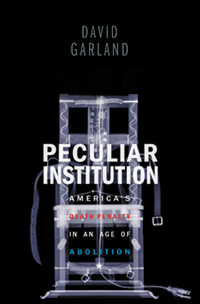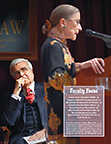The Peculiar Persistence of Capital Punishment
In his highly anticipated new book, David Garland explores what keeps the death penalty alive in the United States.
Printer Friendly VersionDavid Garland was scouting for his next research subject when he came upon an extraordinarily disturbing exhibit at the New York Historical Society: “Without Sanctuary: Lynching Photography in America.” The photographs, taken from the 1890s to the 1940s, captured images of “what looked like medieval public executions performed in front of large crowds,” he recalls. Although Garland is an expert on crime and punishment—he published The Culture of Control: Crime and Social Order in Contemporary Society in 2001—he nonetheless was unaware that such public executions had occurred so recently in America with the cooperation of local law enforcement authorities. “Lynchings were seen as illegal and therefore not part of state punishment, but that is a mistake,” says the Scotland native. While they might have violated federal and state laws, “local law enforcement officers and judges colluded and often handed over the prisoner to the lynch mob,” he said.
Garland, Arthur T. Vanderbilt Professor of Law, wondered whether the idea of a “local legal system” had applications to another historical anomaly he had been thinking about: America’s death penalty. Although most Western countries abolished the death penalty long ago, capital punishment persists in America. Why? In 2006-07, Garland won a prestigious John Simon Guggenheim Fellowship to pursue this question. His answer can be found in his latest book, Peculiar Institution: America’s Death Penalty in an Age of Abolition, from Harvard University Press.

In Peculiar Institution, Garland “places the death penalty in the context of American social and political history, and in the context of world history in a more sophisticated way than has ever been done before,” says James Jacobs, Chief Justice Warren E. Burger Professor of Constitutional Law and the Courts. Adds Bryan Stevenson, who teaches the Equal Justice and Capital Defender Clinic: “It’s a brave work that doesn’t retreat from the legacies of lynching and apartheid, which can’t be separated from the modern death penalty.”
Using the lenses of a sociologist and historian, Garland sets out to answer three puzzling questions: 1. Why has America diverged from other Western nations in retaining the death penalty? 2. How has the death penalty acquired its strange contemporary forms? And, 3. Why does America spend so much time, money, and effort maintaining a system that is so inefficient? While 12,000 homicides are committed every year, just over 100 convicted murderers are sentenced to death, with one-third of that group eventually executed after 12 years of appeals. “It seems obvious that the death penalty is primarily about politics and culture, symbolism and gestures, and much less about crime control,” says Garland.
In his book, Garland argues that the death penalty has persisted in America for the same reason it was abolished so early in some states (Michigan banned it in 1846): the country’s commitment to a radical form of federalism. Like lynching, perhaps the death penalty persists purely because local legal systems allow it. Our political system pushes the power to punish down to state legislatures, local prosecutors, judges, and juries. This local power allowed some states to outlaw capital punishment well before other Western nations did. But it also allows many high-crime states with hostile economic and racial divisions—especially those with a history of slavery and lynching—to hold onto the death penalty. “Capital punishment is often understood as a necessary means of crime control,” Garland says. “But it is better understood as a kind of retaliation against those whose human worth is not valued by their neighbors.”
Garland also traces the history of Supreme Court capital punishment cases, including Furman v. Georgia (1972), argued by Anthony Amsterdam, now a University Professor at NYU, which led to a moratorium, and Gregg v. Georgia (1976), which lifted the ban. This litigation led to safeguards against arbitrary executions, but it also produced layers of legal process that rendered them less effective. The U.S. death penalty is now an attenuated system of delays, deferrals, and inordinate expense.
What keeps the system going is the convergence of political, professional, and popular interests. Politicians know the death penalty is popular with their constituents. Local prosecutors use it to elicit information and guilty pleas. Victims and juries feel wrongs are righted. And the media embraces its entertainment value. “Death provides drama, fascination, and attraction,” says Garland. “In the same way that lynchings drew large numbers of people, the death penalty draws us in.”
Though Peculiar Institution is a social science study that takes a detached view of capital punishment, Philip Smith, who teaches criminology at Yale University, believes the work nevertheless will raise doubts about the death penalty. “Should we feel good about killing people to affirm our autonomy from Washington?” he says. “Garland implicitly suggests that it is immoral to kill people for the sake of electoral or identity politics.” Fordham University School of Law Professor Deborah Denno concurs: “Ironically, by improving our understanding of the persistence of the death penalty in the United States, Garland may help abolitionists to develop more effective strategies.”
—
All of 2010 Faculty Focus


 Multimedia
Multimedia